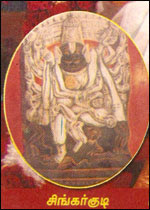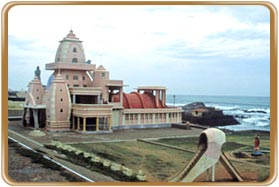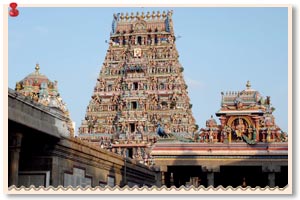Angala Parameswari Temple Melmalayanur : Online Pooja Booking
Angala Parameswari Temple is located at Melmalayanur, 32 km from Gingee in Viluppuram District. The deity of the temple is the Sembadavars. There is an ancient snake pit in the inner sanctum.
Angala Parameswari Temple is located at Melmalayanur, 32 km from Gingee in Viluppuram District. The deity of the temple is the Sembadavars. There is an ancient snake pit in the inner sanctum.
A festival celebrated here during February-March is famous for Simimasana kollai. During the festival many pilgrims cook large quantities of various kinds of grain and set it out in the burning ground. This offering to the goddess is believed to grant wishes. Lots of devotees throng to the temple during Ammavasai (New Moon day).
History of Sri Angala Amman Temple, Melmaliyanoor.
Goddess Mother Parvathi the wife of Lord Shiva took birt on her as hive. The pupose of the birth is to clear Lord Shiva from cetain sin and give blessings to all people in kaliyug. The birth took place her before the start of kaliyug. The birth place melmaliyanoor,where the temple is situated. The specialty in this temple is Mother in Angala amman faces north while blessing devotees.
The great dazzling brightest light is mother Sri Angalaparameshwari was ruling the world even before inhabition started.
Mother parvathy only created Brahma, Vishnu, Rudra, Maheswaran and Sadhasivan for creation, Maintenance, distination, hiding and blessing.
Lord Shiva, Vishnu and Brahma are supported to be three hands of Gods. All of sorts of energies were differentiated mainly as three types, Wish, action and Wisdom. Right Side is taken as male and left as female. When both sides confine together resulted in creation of Sky, Water, Fire Wind and Earth. Siva, Vishnu and Brahma were teamed with Eswari, Lakshmi and Sarswathi.
Brahma, the God for creation had 10 assistants to help in his activities. Thakkan the important assitant crore of living including saint. He also created 60 extremly beautful girls and married them to Godmen. In this process Eswari's creator, He created Dhakshayani and married here to Lord Shiva.
When Takkan went to kailash, He was stopped bygod one of Shiva's deputies. Angered by this takkan performs difficult yagams with selfish maotives. He did not invite Lord shirine. Dhakshyani went to yaga in sprite of Lors Shiva's unwillingness. She accused thakkan for inviting Lord Shiva. But she was only insulted completely dissatisfied, Dhakshayani saw yaga was destroyed.
Dhakshayani destroyed her own body. Lord Shiva took her body and devised with uncontrollable anger (Rudhrathandavam). During this, the right hand of Dhakshayani fell in Dhandakarunyam. Malayanoor is a part of Dhandakarunyam.
Aroop(shapless) Angalaamman to join with Lord Shiva took Birth as Parvathi, the Daughter of parvatharajan. She married Lord Shiva.
With power of manthras and boons from Lord Shiva, Brahama performed a yaga to save god men from two demons known as SANDOBI and SUNDARAR. Thro this yaga thilothama as apsaras came to life.
Attracted by the beauthy of thilothama not only demons but brahma also follwed her. For her protection She went to kailash where Brahma also follwed. As Brahma also was with five heads, Parvathi mistook him for Shiva and felt at his feet. When Parvathi realized the truth, she was very angry and prayed Shiva that fifth head of Brahma should be destroyed.
As Suggested by Lord Vishnu, Shiva fought with Brahma and cut his fifth head. But Brahma was compensated with new head. Shiva cut Brahma's head nine hundreds and ninty nine times and got tired.
He made all the nine huindreds and ninty nine heads into garland and wore it. Then again he cut Brahma's head and confirmed with four heads only.
Shiva was affected by sin due to this. Devi Saraswathi, wife of Brahma cursed Shiva to have no food, no sleep, and his hunger to be quenched with as and thirst to be quenched with bone only. After this Shiva was roaming all over the world.
Saraswathi cures parvathi to become ugly, parts of crane and peacock are to become her dress, her assiatants to become demons.
On knowing this status, Lord Vishnu apprises Parvathi that her ordeal will come to an end when she becomes snake in melmalaiyanoor.
Deve parvathi roams all over the world. She meets sage Kapil in Thiruvannamalai and takes bath in Brahmatheertham. She gets relieved from Sarswathi's curse.
From Thiruvanamali, Devi Parvathi comes to Thazhanur where she stays over night.
Way to malaiyanoor. She creates big lake (ponneri). Her ring is lost in the nearby fields. She curse the lake will not have any fields thereafter. These in true till date.
On the way she felt thirsty. But people there did not oblige her with water. So she curse that are will never have palm trees.
Dasan with 3 sons (Veeran, sooran, Ukiran) went for fishing in Malaiyanoor Lake. Parvathi suggested to them that catch should be devoted to her only Veeran wanted to oblige. But he was sorry for having damaged net.
Angala Amman gave three stones to veeran. The first when thrown in to lake it will make the net all right; second stone will result in catching fishes which is to be devoted to mother. Third stone will result in large catch which can be used for sale. Veeran obeyed the commands.
Then Angalamman created a snake hive in palace garden and set there as five headed snake. Fisherman Dasan unsuccessfully tried to doze the hive. Third day Angalamman gave Darshan to all four fishermen.She commanded the fishermen, Due to Saraswathi's curse i am here. Daily you do Pooja to me. I will save you and your future generations. Accordingly fishermen perform pooja even now.
King of the place Malai Arasan came to gardens and saw the snake hive temples. He got angry with Dasan's family. he sent a great force to destroy the snake hive. Mother made everything invisible and geve dharshan to the king, Who donated twelve kanni lands for building the temple.
People took sand from snake hive as prasad and got relief from diseases. Lord Shiva crosses river sangraparani and reaches Melmalaiyanoor. In cremation ground consumes three handful of ash and gets some relief from hunger. Then he asks for food in front of the temple. On hearing Shivas voice Parvathi feels happy and thinks of her brother Vishnu who appraises the procedure for relief from curse.
That Moment she had consultation with Lord Vishnu. He advised her that Tasty food is to be prepared in three parts. the fist two parts are to be given to Kabalam, Third part is dropped in the floor as if by mistake, then when Kabalam comes down to taste the food parvathi should take giant shape and squeeze it. Then the curse will be released. To cook the food she should take the help of lakshmi and Amudha Surabi
Parvathi prepared food accordingly. She orders Lord Ganesh to take care of his father till the lunch is over. Ganesh obeyed his mother's word. Parvathi performed pooja to the feet of Lord Shiva and served lunch as suggested by Vishnu. When Kabalam come down to eat the third part of food, Parvathi took giant shape of Angala Prameshwari and crushed it with right foot and made it as her servant.
As Shiva was released from curse he felt happy and went to Chidambaram for Dancing happily. He got the name of Dhandeswarar and Parvathi as Dhandeswari.



 The car festival is a 10-day celebration for the small town of Ariyalur. The festival starts with the day of "Srinavame" in the month of Chithirai or Panguni (March-April). The grand event of Eganthem Sevai for Varatharajapermual is on 10th day of festival. The festival attracts people from all over the state of Tamil Nadu.
The car festival is a 10-day celebration for the small town of Ariyalur. The festival starts with the day of "Srinavame" in the month of Chithirai or Panguni (March-April). The grand event of Eganthem Sevai for Varatharajapermual is on 10th day of festival. The festival attracts people from all over the state of Tamil Nadu. 




















 Kanyakumari forms the southern most end of mainland India. It is also the place where the Arabian Sea, the Bay of Bengal and the Indian Ocean merge. Kanyakumari has been a great center for culture, civilization and pilgrimage for years. Kanyakumari is named after the virgin goddess Kanyakumari whose temple is situated here.
Kanyakumari forms the southern most end of mainland India. It is also the place where the Arabian Sea, the Bay of Bengal and the Indian Ocean merge. Kanyakumari has been a great center for culture, civilization and pilgrimage for years. Kanyakumari is named after the virgin goddess Kanyakumari whose temple is situated here.  To add some variety to your temple journey visit the Parthasarathy temple in Chennai. Though the common features of ancient temples are very much prevalent in this ancestral temple but it has some striking features, which makes the temple outstanding among others.
To add some variety to your temple journey visit the Parthasarathy temple in Chennai. Though the common features of ancient temples are very much prevalent in this ancestral temple but it has some striking features, which makes the temple outstanding among others. Child, marriage, education, wisdom, business development, good yielding in farming family welfare are the boons devotees seek from the Lord here.
Child, marriage, education, wisdom, business development, good yielding in farming family welfare are the boons devotees seek from the Lord here. The car of the temple is built with high technical and artistic skill. Beautiful carvings adore the car in all sides. From the inscription of the date of making the Car as Shalivahana Sahabdam, Kollam 1025, Soumya Year, Avani month 13th day, one can imagine the antiquity of this car.
The car of the temple is built with high technical and artistic skill. Beautiful carvings adore the car in all sides. From the inscription of the date of making the Car as Shalivahana Sahabdam, Kollam 1025, Soumya Year, Avani month 13th day, one can imagine the antiquity of this car. Srivilliputhur is 50 Km from Virudhunagar, 8 from Sattur, 32 from Aruppukottai, 82 from Tirunelveli, 90 from Madurai. There are lodges in the place the charges ranging from Rs. 100 to Rs. 300.
Srivilliputhur is 50 Km from Virudhunagar, 8 from Sattur, 32 from Aruppukottai, 82 from Tirunelveli, 90 from Madurai. There are lodges in the place the charges ranging from Rs. 100 to Rs. 300.